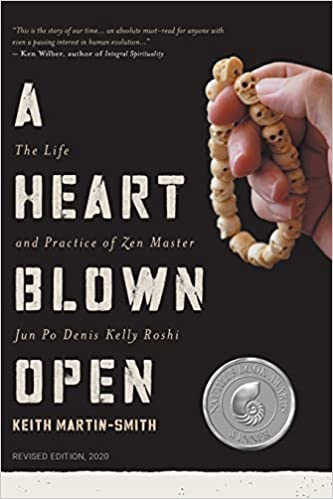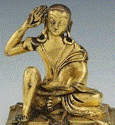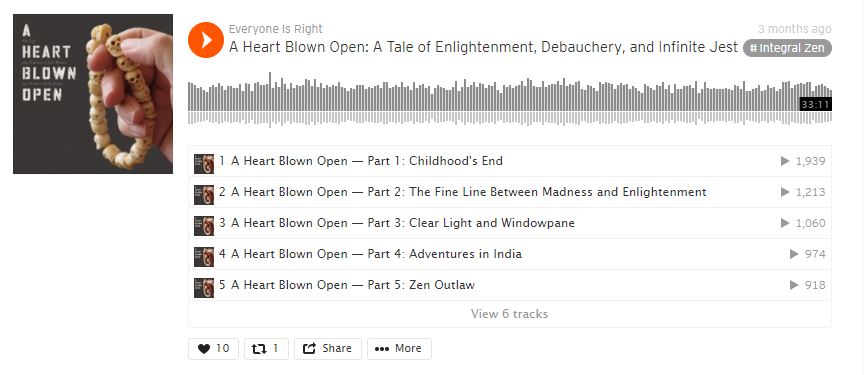
A Heart Blown Open chronicles the extraordinary journey of Zen master Jun Po Denis Kelly Roshi, whose life landed him in prison long before he landed in a monastery. Experience the successes and failures that led him to found an entirely new form of Buddhism called Mondo Zen. Starting from an abusive and alcoholic home in Wisconsin, Kelly becomes a major force in the counterculture of the 1960s and one of its biggest manufacturers of LSD. He ends up on the run for five years before serving time in a federal prison, and then goes on to spend six years in a Zen monastery. In his fiftieth year, he becomes a recognized Zen master in his own right, but the real journey is just about to begin.
Extraordinary in their playfulness, depravity, and liberating insight, Jun Po’s life events swirl together to underscore and illuminate the environment from which one of the most controversial masters of the American Zen scene has emerged. A Heart Blown Open constitutes a powerful synthesis of Eastern contemplative wisdom and Western psychological insight and is as entertaining as it is inspirational.
Junpo Denis Kelly (1942-2021), received his Zen Masters recognition in 1992. He was Vice Abbot and head monk as well as resident yoga teacher at Dai Bosatsu Zendo Kong Ji in the Catskill Mountains in New York state from 1987 through 1993. His Inka Zen lineage was in the Rinzai tradition, through Eido Shimano Roshi of the The Zen Studies Society. His yoga lineage was that of BKS Iyengar and Patabi Jois. Junpo had been practicing, studying and teaching Zen and Yoga for over twenty-five years at the time of his passing in May 2021.
Jun Po Denis Kelly was born to a military family in northern Wisconsin on April 14, 1942. A troubled youth and an early spiritual hunger led him west to California in 1963, where he was quickly taken up in the exploratory ferment of the counterculture. He became a first-generation psychonaut and self-described “urban shaman,” a friend of Alan Watts and the Grateful Dead, a contemporary of Ken Kesey’s Merry Pranksters, and one of the freewheeling inventors of the legendary Clear Light “Windowpane” LSD. He also began a dedicated study of Buddhist meditation, spending time with both Shunryu Suzuki Roshi and Chogyam Trungpa Rinpoche before finally meeting the man who would become his teacher, Rinzai Master Eido Shimano Roshi of the Zen Studies Society in New York.
“I had no idea what it was, of course—not until I encountered lysergic acid diethylamide [LSD] many years later and had the same experience of moving into that causal space. I had no language for it at the time, but I think that moment was really the motivation for my whole spiritual path. To be able to suddenly find myself, simply because of stress, in this experience of nondual mind . . . There was just nowhere to place it. The idea of traditional religion certainly didn’t line up with that deep insight. Growing up, it just created this huge question of What? If you asked me, “What do you mean, what?” all I could say was, “What?””
……..
“I went to California out of frustration. I certainly couldn’t find any help in the 1950s and ’60s in northern Wisconsin. So I went to the West Coast and discovered that there was this whole other universe, a whole other way of being and looking at things. I got into a relationship with a woman who introduced me to mescaline, and I began to have these extraordinary subtle experiences—vivid hallucinations, that whole classic experience of the subtle realm. When I looked through those eyes at the world, I could not believe America. I could not believe how people behaved or how they understood the nature of their emotional body or intentions. I went on to experiment with other compounds like ayahuasca and dimethyltryptamine [DMT], but it wasn’t until I encountered LSD in San Francisco that I finally penetrated back into that causal state again and slowly began to understand and realign for myself that experience I’d had when I was a child.
I was in my early twenties at the time. 1965. The kids were younger than I was; they were all teenagers, it seemed. Eventually, I got invited within the psychedelic community in San Francisco to consider getting involved in manufacturing LSD, and I thought of it as a vehicle for bringing deep and profound insight to our culture, so I agreed. I became the head of a “family”—an extended community in the psychedelic world—that produced a product called Clear Light, and then later Windowpane. There were twenty-eight people spread out around the world, mostly in the United States, and we made around thirty million doses over ten years. We gave away large, large quantities at concerts. This was very common during that time, with the Grateful Dead and Janis Joplin and the Airplane. We’d go to the parties, the big concerts, which were the gatherings of the tribes, you know, the psychedelic music fairs, and the different families would come and give their LSD away.
I was the one who built up our distribution network. I hung out with the Grateful Dead. Took a few drum lessons with Bill Kreutzmann, as a matter of fact. I had a backstage pass, meaning I’d just walk in and out of the place. We called ourselves the Order of the Golden Toad. I melted down a seventeenth-century French Roman Catholic chalice and had it cast into golden frogs. We’d have a ritual initiation after you were with the family for a while, and everyone got a golden frog. So we all wore these frogs on chains. That was our symbol. I still have it on a necklace that I wear occasionally.”
……..
“By 1970, my face had become known, and I had to go underground. For the next ten years, I was actively being sought by the Drug Enforcement Administration, with a fifty thousand dollar cash reward for information leading to my arrest. So I disappeared into the forests of Oregon. My partner took over the distribution network, and I joined my other partner in the lab in actually synthesizing LSD.
I remember having several arguments around the issue of purity with Owsley Stanley—the Bear. We didn’t want anyone to adulterate our LSD; it had to be 250 micrograms of 100 percent “D-normal” so that you could have a nondual experience. It had to be perfectly dry and absolutely pure, and we were quite dedicated to that. To control the purity, we’d cast it in a thin layer of gelatin. Then we’d cut it into tiny one-tenth-of-an-inch squares that you could look right through, which is why it came to be known as Windowpane. So you could no longer adulterate the product. But now it would be subject to light, and LSD will equilibrate when light hits it. It flips from the D-normal to the “isomer,” and that makes LSD speedy. This was the argument I had with Owsley. He felt strongly about not subjecting it to light, and I was more interested in preventing people from polluting the product. Who leaves their LSD lying around in the sun anyway?”
……….
“I eventually spent ten and a half months in federal prison in 1981. In 1984, I was ordained, and I opened the Kanzeon Zen Yoga Center in Marin County, California. I loved threes, sixes, and nines, so I taught three hours in the morning and three hours at night, 6:00 to 9:00, 6:00 to 9:00, six days a week for four years. It was one of the most extraordinary periods of my life. When you’re practicing six hours a day, everything just works. But I was still having problems with my own ethical interpretation of reality, and that pulled me to return to the monastery for classical training. I’ve always been a reasonable, kind person, but occasionally I would do something really stupid, and I needed to know how I could integrate the deepest nondual insight I’d had into my life 24/7. How did all of that work?
When I asked Eido Roshi if I could be trained, he just grinned and said, “Jun Po, I think you’re worth civilizing.” So I went back to Dai Bosatsu and spent six years at the wall. First I was head monk, and then vice abbot until I resigned in 1993.
Three years ago, I was diagnosed with stage IV throat cancer. Through deep meditative practice, I’ve had the so-called classic insights. Through psychedelics, I’ve had the rocket-ride insights. But cancer added an element of death that really surprised me. The cancer itself is easy. It’s the radiation and the chemo that are the problem. Chemotherapy actually dissolves the neural connections in your brain. You start to die in a very different way—slowly, physically. They really march you right down towards death’s gate.
During four months of treatment, I watched myself slowly die and go into states of dissociation and confusion. By the time it was done, the chemo fog and the radiation burn had actually changed my psychology. I became seriously depressed, which was a very interesting experience. I would try to practice. I’d drag myself to the cushion or try to do my yoga or something, and I would fall over and just lay there. And then slowly, slowly, you know, I came back out of it. I had actually seriously considered suicide. Not out of self-pity, but just because it felt totally unacceptable for an intelligent man to continue dragging a carcass and half a brain around. If you had any character, you’d kill yourself.
That actually frightened me. But out of it came a new degree of compassion and empathy and a real letting go, hopefully, of the last remnants of my arrogance. Through moving in and out of this death pattern, I had the realization once more: There’s no there there. After everything I’ve been through, to watch my little ego and all my temporary self-referencing dissolve away all over again was something quite exquisite.”

Listen
In this provocative and exhilarating dialogue, Jun Po Roshi and Ken Wilber take an in-depth look at Keith Martin-Smith’s new book: A Heart Blown Open: The Life and Practice of Zen Master Jun Po Denis Kelly Roshi.
For most of us, we would need to reincarnate at least 50 times in order to attain such an incredible volume of experience. But for whatever reason, it seems that Jun Po went a slightly different route, and chose to live all 50 of those lives at once.
Here is his remarkable story—a riveting tale of enlightenment, debauchery, and infinite jest.
One of my favorite encounters with Jun Po Roshi was a night I spent driving him from the San Jose airport to Pacific Grove, during our last Integral Spiritual Experience event. A few minutes into our three-hour drive, I asked him what his favorite Beatles album was. “Sgt. Peppers,” he replied, so I played the album on my iPhone. I explained to him that I was raised on a steady diet of this music, and had always felt a slight envy that his generation got to experience the explosion of rock and roll culture firsthand.
“This music—it makes me feel nostalgic for a time before I was born,” I told him.
“Well get ready,” he shot back, “because that time is coming sooner than you think.”
At that moment it struck me as the funniest thing I had ever heard. A perfect Zen joke. A surge of laughter bubbled up from my belly, and as it erupted out of my face, something *popped* inside my consciousness. For just a second, reality flipped itself inside-out, and all that remained were the trembling aftershocks of laughter and a big, beautiful Buddha smile radiating from the back seat of the van, as we continued down the black highway that stretched before us.
This perfectly-timed sense of humor, of course, is one of Jun Po’s finest and most endearing qualities. There’s no denying it: the man’s got jokes. But these are not just your standard gags and quips—there is transmission in Jun Po’s humor. In fact, his wit is almost as important to his teaching as his wisdom, and he uses it to set the ego at ease while preparing it for it’s own oblivion, leading us to the infinite absurdity at the very core of our existence. Samsara is a joke, and this very moment is the punchline.
Another remarkable quality of Jun Po Roshi that really comes through in this dialogue: he is not the type of guy to sweep his shadows beneath the rug of enlightenment. Rather, he chooses to meet them head-on, using the curative, self-liberating quality of consciousness to extract transcendent light from some of the deepest, darkest parts of his psyche. These might very well be the most admirable aspects of Jun Po’s character: his unabashed and unflinching honesty, his willingness to confess and take full responsibility for his own flaws and mistakes, his unshakable presence and courage as he embraces the pain and stands in the purifying flames of redemption. Jun Po Roshi accepts light and shadow alike as intrinsic elements of his spirituality, exemplifying the Tantric ideal of “bringing everything to the path” by neither avoiding nor excluding the more onerous and destructive facets of our lives. Instead, he urges us to face them directly, to work with them intimately, and to ultimately transmute them into wisdom, virtue, and compassion.
Jun Po Kelly Roshi’s story is truly remarkable, and when coupled with his radiant personality and wily sense of humor, would no doubt make for a wildly entertaining and enriching Hollywood blockbuster. Even more intriguing, his story echoes a narrative even greater than his own (as all truly great stories do)—it is hard to think of anyone who better personifies the remarkable progression of American spirituality from the 1960’s until today, standing as he does with one foot firmly planted in the sixties counterculture, and the other in today’s Integral renaissance.
Written by Corey deVos
A Heart Blown Open: A Tale of Enlightenment, Debauchery, and Infinite Jest

A Heart Blown Open: The Life and Practice of Junpo Denis Kelly Roshi (revised, 2020) Paperback – December 11, 2019


